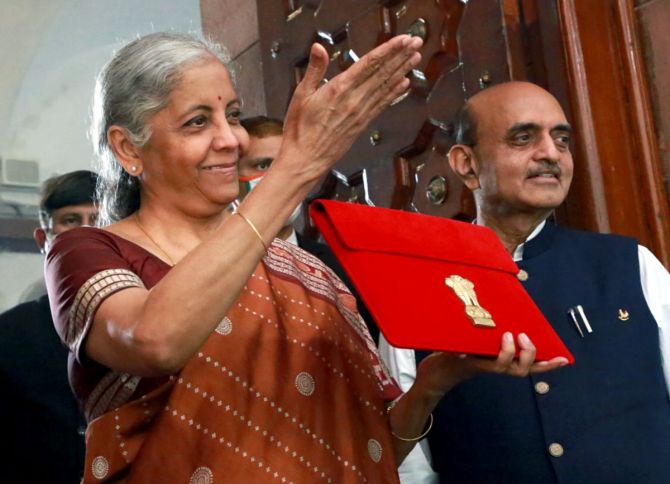At the customary post-Budget media interactions, Finance Minister Nirmala Sitharaman and her topmost bureaucrats touched upon a number of issues.

The minister said the government taxing income from digital virtual assets did not give them legitimacy and that issue was being dealt separately in the planned cryptocurrency Bill.
She also expressed confidence that the Budget targets were achievable.
Key takeaways from Sitharaman's fourth Budget:
On cryptocurrencies
The RBI will be issuing a digital currency.
A currency can be issued only by the central bank even if it is a cryptocurrency.
Anything outside that though we refer to them as currencies, they are not so.
Buying and selling is happening and profits are being made, and nothing stops me from taxing them.
Taxing does not confer on them legitimacy.
We are not taxing a currency (digital rupee) that is yet to be issued.
Everything outside this is an asset created by individuals, and if profits are made in transacting that asset, it will be taxed at 30 per cent.
We are also tracking every trade in the crypto world by imposing 1 per cent tax deducted at source.
We have circulated a paper, and are receiving inputs.
Public stakeholders are also giving their inputs.
So regulation will go through that process, and we will not wait for regulation to tax people earning profits from such assets.
On Budget estimates
In the February 2021 Budget, we were told we had been conservative, but we were right in our assessment.
And being conservative is not being overly optimistic.
We are sure we will achieve the numbers, and will probably top them.
On revenues
If revenues are compared to the size of GDP, excise duty cannot be linked to that because it doesn’t increase as prices go up.
So if excise duty collection is removed from the revised estimates, projected growth in revenues is 14 per cent, said revenue secretary Tarun Bajaj.
This is not conservative, but a very pragmatic number, and the government will make all attempts to achieve it.
Higher borrowing
The borrowing number indicates the fiscal deficit minus the small savings scheme collection.
This is not artificial, but a very realistic number.
It’s done using the best estimate of collections from small savings schemes, said Finance Secretary T V Somanathan.
The money raised through green bonds will be part of the overall borrowing.
In the coming days, these bonds will be used for specific projects.
The expectation is that there are investors who are ready to invest in less carbon-consuming projects.
For such a class of investors, we have to build that market which is the future, said economic affairs secretary Ajay Seth.
The government is in discussion with the RBI and market participants and size of issuance of such bonds will be decided soon.
On divestment target being slashed
Keeping a high divestment target sometimes distorts the market, said DIPAM secretary Tuhin Kanta Pandey.
Nothing stops us from achieving what we want to achieve in dinvestment.
Ongoing transactions will be carried out.
The LIC IPO, in all probability, will be brought this fiscal year.
With revised estimates at Rs 78,000 crore, we should not conjecture on the size of the IPO as the valuation of LIC is yet to reach a conclusion.
The Draft Red Herring Prospectus of LIC will be filed with Sebi within 10 days.
And there have been instances of receipts being different from the estimated numbers.
In our assessment we have shown the intent of the government by privatising Air India and Neelachal Ispat Nigam Ltd.
I think we have been realistic in planning what we want to do and achieving what has been planned, said Sitharaman.
The minister also said the Centre’s internal estimates of what it expected from LIC IPO had not been included in the revised estimates.
On job creation and capex
Infrastructure spending will be Rs 5.5 trillion this year. Next year, public investment will increase to Rs 7.5 trillion.
Increase in capital expenditure will create a positive impact on job creation.
Spending on asset creation will help in creating jobs.
Besides that, government is giving incentives under the PLI scheme in 14 sectors, which will also help in creating jobs.
The government recognises that for private investment to pick up, it is clear that public investment will have to be increased.
Photograph: Amlan Paliwal/ANI Photo












 © 2025
© 2025